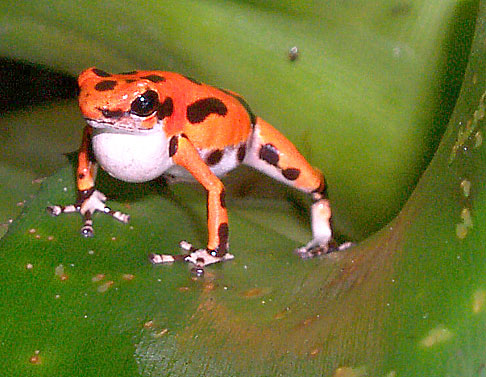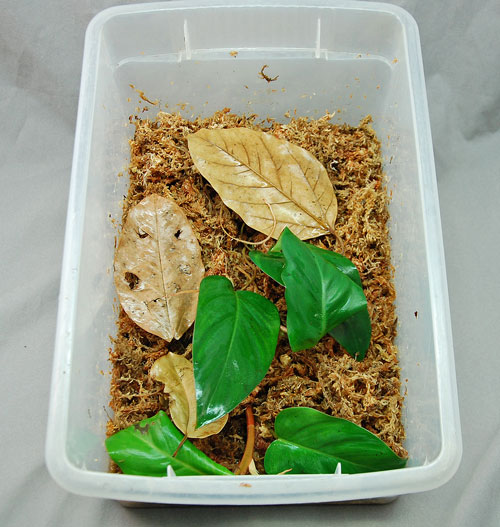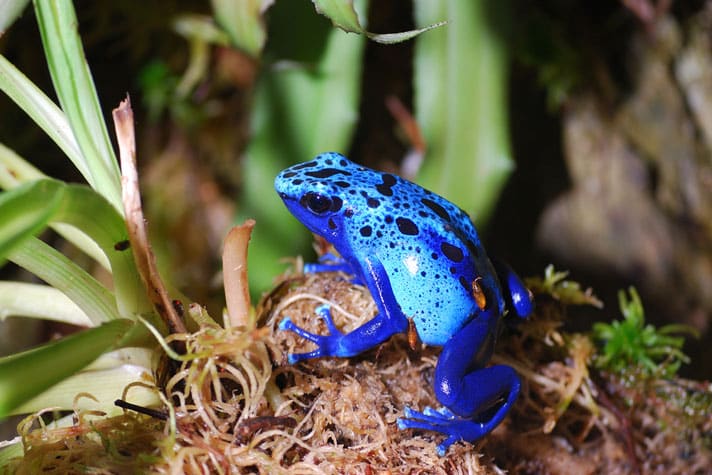Care sheet for the poison dart frog (Dendrobates spp.).
Updated February 3, 2023
Poison Dart Frogs (Dendrobates spp.)
Poison dart frogs are one of the most colorful and fascinating pets in the reptile and amphibian world. These frogs display a variety of interesting interactions and have some of the most complex breeding behaviors in the hobby. Unlike most amphibians, poison dart frogs are diurnal (active during the day), so all of their activity is carried out right before your eyes! Because poison dart frogs are relatively small, they can be housed in a beautiful “slice of the rainforest” terrarium with lush vegetation, waterfalls and even orchids.
There are many misconceptions about poison dart frogs and their care. The most common concern about these frogs is related to their poisons. With their ominous sounding name, and the hype about their poisons, it’s no wonder there is a fair amount of confusion about their status. Are they dangerous? Are they safe to keep in the home, or best left to zoos? So, here is the straight story!
First, and most importantly, poison dart frogs are completely non-toxic when captive bred. Even wild-caught frogs gradually lose their poisons in captivity. (Wild-caught poison dart frogs should always be treated with caution, due to the possibility that there skins may contain poisons.) In order to create their toxins, poison dart frogs need certain chemicals, which are present in the insects they eat in the wild. The exact nature of these ingredients is poorly understood at this point, but one thing is known for sure, these poisons are not in their diet in captivity.
The poison is what gives the frogs their name, and over the years these frogs have been called by a number of different names by hobbyists. Sometimes people call them arrow frogs or poison arrow frogs, but this is inaccurate, as the frog’s poisons were never used to tip arrows, only blowgun darts. At this point the most widely used name in the hobby is poison dart frogs, often shortened to just dart frogs.
Where to Get a Poison Dart Frog
Poison dart frogs are commonly bred in captivity. Captive-bred poison dart frogs are available from breeders, at pet stores and at reptile shows. Wild-caught poison dart frogs do show up fairly regularly in the hobby, but I suggest sticking with captive-bred frogs. You can run into a variety of potential problems with wild-caught frogs. I strongly recommend you establish relationships with knowledgeable vendors, preferably breeders, and make sure they’re willing to provide follow-up support.

Photo © Saurian.net. by Patrick Nabors
Strawberry dart frog.
Poison Dart Frog Size
Poison dart frogs can be divided up into two or three different size groups. The species that are most popular in the hobby are medium to larger size poison dart frogs. As adults, these frogs are generally about the size of a large grape, or around one and a half inches in length. Maximum size for any poison dart frog is about two and a half inches.
In addition to the large poison dart frog species, a variety of smaller species are also available. The smallest of these species are called thumbnail frogs, due to the fact that they’re small enough to sit on a person’s thumbnail — with room left over! These smaller species are a bit trickier to keep, and it’s important to get some experience with the larger poison dart frogs before trying the smaller species.
When you go looking for your first poison dart frogs, you will find that most vendors are offering babies and juveniles. Baby poison dart frogs, or frogs up to around six weeks old, are only about a half inch long, and should be avoided. These small frogs will be more difficult for the beginner to get established, and are generally more fragile. A much better bet is to find a breeder who can offer you juveniles, or three to five month old frogs, usually three quarters of an inch up to a bit over an inch. These larger juvenile frogs are generally going to be more well established, and will be more likely to thrive for you!
Poison Dart Frog Life Span
Although there have been occasional reports of poison dart frogs living more than 20 years in captivity, a more typical life span is four to eight years.
Poison Dart Frog Enclosure
Most poison dart frogs are sold as juveniles or babies, so at this size, they do best if housed in a small container. I recommend a sweaterbox or similar size translucent sided container. Something around 12 inches wide and long, is good. A moist substrate, such as long-fiber sphagnum moss, and a few leaves for hide spots are all you need. Keep one to two poison dart frogs in this size container until they’re well-established in your care, feeding well and growing. The larger your terrarium is, the larger the frogs should be, before you put them into the tank. We generally recommend to our customers that they keep the frogs they get from us in these temporary setups for around six weeks.

Photo © Saurian.net. by Patrick Nabors.
You should keep your juvenile poison dart frogs in a small container such as the one above for several weeks, before they are introduced into a larger terrarium.
Keep in mind that the plastic sweater box is recommended for several reasons, and if you wish to substitute a different type of container you need to make sure it will provide the same conditions. In particular the sweater box doesn’t have any ventilation, which is good, it will keep your humidity nice and high. Don’t worry, there will be plenty of air for the frogs, provided by your opening the top every day or two.
Another thing that is nice about these boxes is the fact that they feature translucent sides, not clear, which gives the frogs some security. If you elect to use a clear container, it should be placed against a wall, or two or three sides should be covered with paper. The final benefit of the small container is that it allows the younger frogs, which are more timid hunters, to have a much easier time finding their food. The small container size, and simple setup, serves to concentrate the food and make it more available to your young frogs.
When they grow larger, poison dart frogs enjoy spacious tropical terraria. Standard glass fish tanks and front-opening terraria are both good choices. The keys to success are to avoid overcrowding these frogs and to keep a stable group together rather than adding new frogs to the tank. Some rules of thumb are to put no more than two poison dart frogs in a ten gallon tank, three dart frogs in a twenty gallon tank, and so on. You should do your research before putting groups of dart frogs together, some species are more territorial than others, and won’t do well in group settings.
Poison Dart Frog Lighting and Temperature
Poison dart frogs are very easy to care for in terms of lighting and temperature. Even though these frogs originate from hot, steamy rainforests, most poison dart frogs actually live on the forest floor where temperatures are cooler and the lighting is dim.
In the terrarium, poison dart frogs prefer moderate temperatures. Daytime temps between 72 and 80 degrees Fahrenheit are ideal. More than a few hours at about 85 degrees can be deadly. Make sure to set your tank up and run it for a few days, while monitoring the temperatures in the tank, before you put the frogs in. Remember your frogs when things get warmer, and the room they are in heats up. The frog tank will run a few degrees warmer than your room does due to the lighting on the tank, so make sure you keep this in mind!
No special lighting is needed for these frogs. Most poison dart frog species need just enough light to see their food. For the usual ten or twenty gallon tank, a 20 watt fluorescent bulb will do the trick. However, the terrarium will look better with brighter lighting, and the plants will do better. Brighter lighting is usually achieved with power compact fluorescent bulbs, or the new T-5 fluorescent bulbs, in fixtures with reflectors that maximize the light that gets into the tank. I recommend at least a single 55-watt power compact bulb, or two 20-watt T-5 bulbs for a twenty gallon tank, and of course increasing wattage as the tank gets larger. These higher output lights will make it possible to keep many of the more interesting plants included in frog habitat products, such as bromeliads and miniature orchids. One draw back to adding high-output lighting is that these bulbs produce more heat, so cooling fans may be needed to keep tank temperatures within range. Be sure to avoid incandescent bulb lighting, as it is likely to overheat the tank.
Poison Dart Frog Substrate
Poison dart frogs do well on many types of substrate. Several soil mix recipes exist, but my personal experience leads me to the conclusion that a nonorganic substrate is ideal in the wet conditions of a poison dart frog terrarium. Organic substrates rot or sour fairly quickly, and this can cause the tank to take on a swampy smell and begin to culture fungus gnats. One of the worst substrates in this regard is ground coconut husk, which rots in a matter of months. My breeding facility has been using one-eighth-inch natural aquarium gravel in tanks for many years. This substrate looks natural when the tank is decorated with plants, dried leaves, cork-bark hide spots and patches of moss.
Poison Dart Frog Food
Poison dart frogs are strictly insectivores, and will only eat small, live insects. Frogkeepers use a variety of insects, but the two most common types are flightless fruit flies and crickets. I strongly recommend flightless fruit flies as the primary food source for your poison dart frogs. Culturing them is fairly easy and should only require a few minutes of work every couple weeks. Supplies to culture your flies are fairly inexpensive. Crickets are also a good food source, but challenges can make them impractical. For example, very few pet stores carry crickets that are small enough for poison dart frogs. Crickets also grow rapidly, and thus quickly become too large for poison dart frogs. Whatever you feed your dart frogs, make sure to dust food items before every feeding with a high-quality calcium and vitamin supplement.
Many beginners are unsure how much food their dart frogs should be eating. Because poison dart frogs eat tiny food items, they need to eat lots of them. Feed juveniles every day, whenever possible, and provide about twenty or thirty fruit flies per feeding. A young-adult poison dart frog is capable of eating 50 to 75 fruit flies in a day, and it should be fed this amount four or five days a week. Once your poison dart frogs are established and doing well with fat bellies, you can leave them for several days without worry of them needing to eat. As adults, as long as they’re in good shape, they can occasionally go a week without being fed.
Poison Dart Frog Water
Poison dart frogs, like all frogs, do not drink water; they absorb it through their skin, from their surroundings, both from the air in their terrarium, and small water pockets and droplets on leaves and other surfaces in the tank. High humidity is a key to keeping these frogs happy, which can be measured using thermo-hygrometers. Dart frogs will be happy with the humidity close to 100 percent, but will tolerate it as low as around 80 percent, before they decide it’s too dry for their tastes and hide. The true gauge of your dart frog’s satisfaction with the humidity level is their behavior. If your frogs are hiding and you don’t see them much, try cutting back on the ventilation. Poison dart frogs don’t need or enjoy ventilation, especially when the air that is “ventilating” their tank is dry household air. Not to worry, the dart frogs won’t suffocate, the plants will provide oxygen, and regularly opening the top for feeding will also exchange the air. High humidity in the tank will keep your poison dart frogs hydrated and active. No water bowl is needed for a poison dart frog terrarium.
If you do have a water container, make sure to treat the water with a chlorine-removing product, such as API Tap Water Conditioner. Also, make sure to change the water regularly, because dirty standing water is a leading cause of bacterial infections.
Poison Dart Frog Handling and Temperament
Poison dart frogs are small and have delicate skin, so they’re best treated as hands-off pets. Handling poison dart frogs briefly to move them or to cup them for shipping is fine. But handling them for more than a moment or two can definitely be dangerous to their health. If you do need to catch poison dart frogs, firmly but loosely grasp them, and put them into a holding container. As stated earlier, captive-bred poison dart frogs have absolutely no poisons in their skin. However, as with any reptile or amphibian, after working with or handling your frogs, you should always wash your hands.
Patrick Nabors owns Saurian Enterprises, found at Saurian.net on the Web. Here you will find much more information on dart frogs, as well as a full line of dart frogs and supplies for keeping dart frogs!


